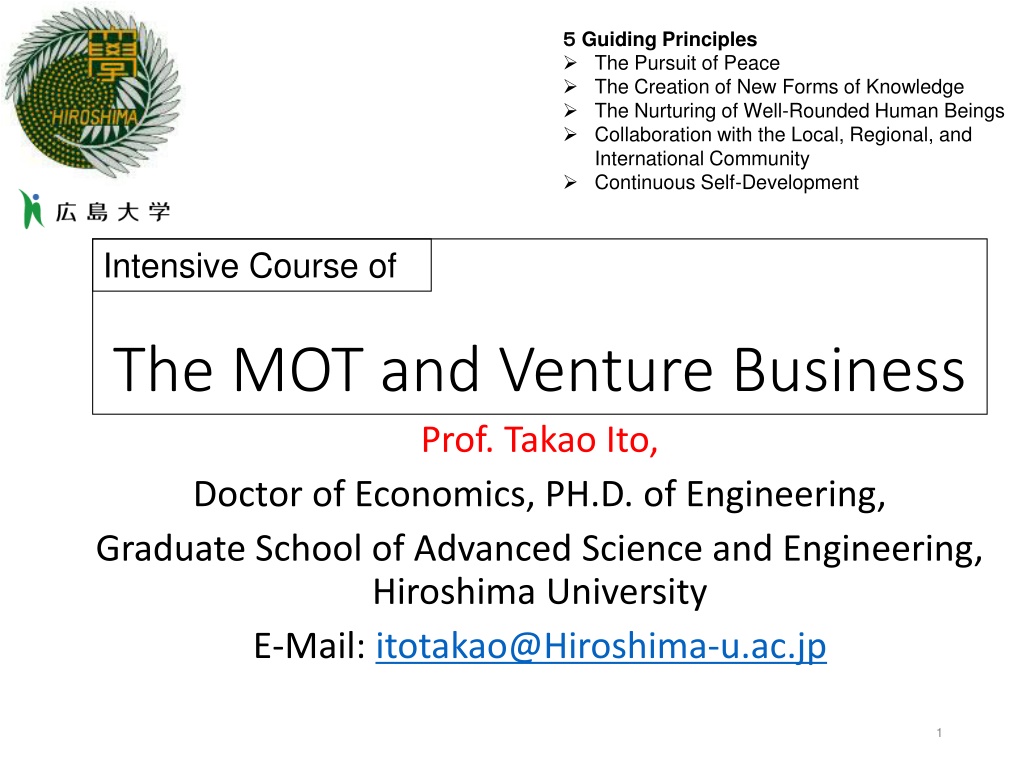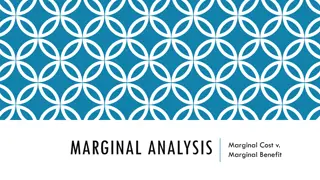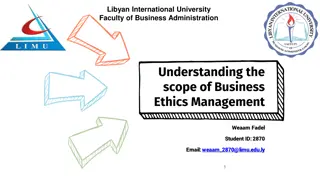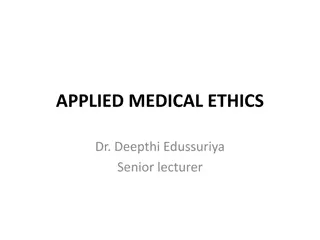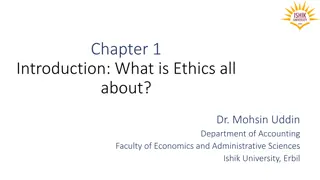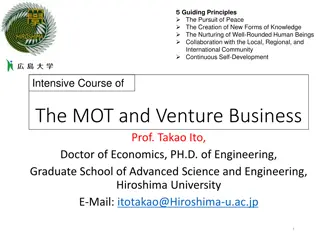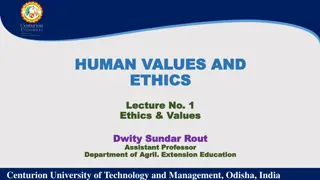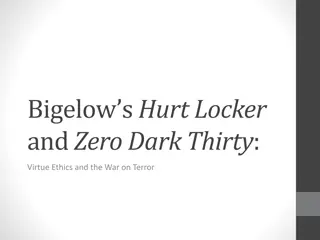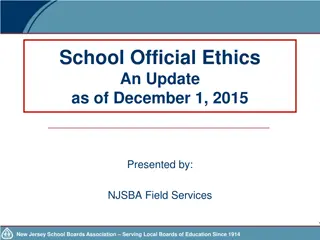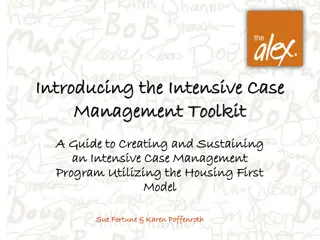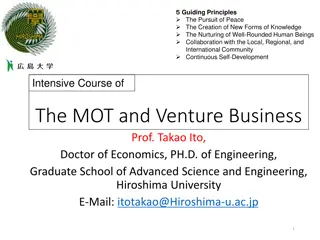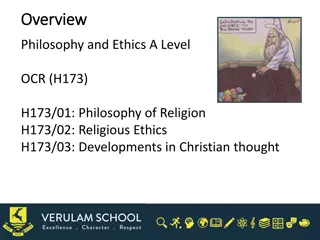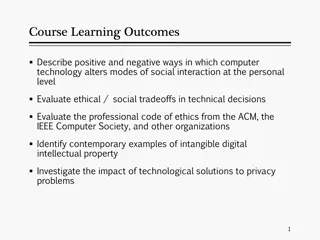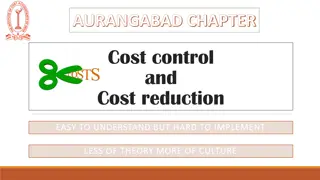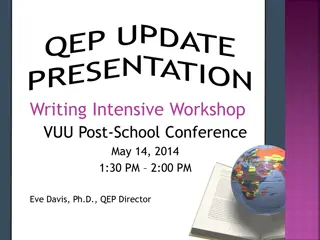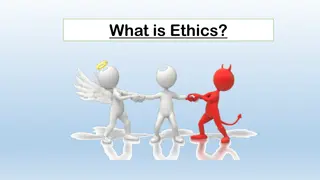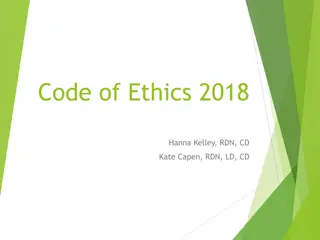Intensive Course in Business Management: Cost Benefit Analysis and Ethics
Explore the principles of Cost Benefit Analysis and Ethics in a comprehensive business management course led by Prof. Takao Ito. The course covers topics such as decision-making, leadership, and organizational structure to cultivate well-rounded individuals and foster collaboration with the community.
Download Presentation

Please find below an Image/Link to download the presentation.
The content on the website is provided AS IS for your information and personal use only. It may not be sold, licensed, or shared on other websites without obtaining consent from the author. Download presentation by click this link. If you encounter any issues during the download, it is possible that the publisher has removed the file from their server.
E N D
Presentation Transcript
Guiding Principles The Pursuit of Peace The Creation of New Forms of Knowledge The Nurturing of Well-Rounded Human Beings Collaboration with the Local, Regional, and International Community Continuous Self-Development Intensive Course of The MOT and Venture Business Prof. Takao Ito, Doctor of Economics, PH.D. of Engineering, Graduate School of Advanced Science and Engineering, Hiroshima University E-Mail: itotakao@Hiroshima-u.ac.jp 1
Schedule MOT and Venture Business (An Intensive Course) 08:50-16:20, Saturday and Sunday No. Date 1 2023/10/21Sat Outlines and Introduction 2 2023/10/21Sat The evolution of Management 3 2023/10/21Sat Key Issues in Corporate Management 4 2023/10/21Sat Break-Even Point Analysis 5 2023/10/22Sun Cost Benefit Analysis and Ethics 6 2023/10/22Sun Stock Control 7 2023/10/22Sun Case Studies and Group Discussion 8 2023/10/22Sun Kaizen and Quality Control 9 2023/11/11Sat Motivation (self Learning) 10 2023/11/11Sat Organization Structure 11 2023/11/11Sat Decision-making and Strategy 12 2023/11/11Sat Leadership 13 2023/11/12Sun Business Plan 14 2023/11/12Sun Entrepreneur and Venture Business 15 2023/11/12Sun Presentation and/or Final Examination 16 2023/11/12Sun Review and Free Discussion Lecture 08:50-10:20 10:30-12:00 13:10-14:40 14:50-16:20 08:50-10:20 10:30-12:00 13:10-14:40 14:50-16:20 08:50-10:20 10:30-12:00 13:10-14:40 14:50-16:20 08:50-10:20 10:30-12:00 13:10-14:40 14:50-16:20 2
Agenda 1. Cost Benefit Analysis 2. Ethics and Ethical Issue 3. Utilitarianism vs. Cost Benefit Analysis 4. Responsibilities 4
1Cost Benefit Analysis A cost benefit analysis is done to determine how well, or how poorly, a planned action will turn out. The difference between benefits and costs whether the planned action is advisable. The real trick to doing a cost benefit analysis well is making sure you include all the costs and all the benefits and properly quantify them.
An example of Cost Benefit Analysis As the Production Manager, you are proposing the purchase of a $1 Million stamping machine to increase output. Before you can present the proposal to the Vice President, you know you need some facts to support your suggestion, so you decide to run the numbers and do a cost benefit analysis. You itemize the benefits. With the new machine, you can produce 100 more units per hour. The three workers currently doing the stamping by hand can be replaced. The units will be higher quality because they will be more uniform.
A stamping machine You calculate the monthly cost of the machine, by dividing the purchase price by 12 months per year and divide that by the 10 years the machine should last.
1. Purchase of Machine .................... -$20,000 includes interest and taxes 2. Installation of Machine ................. -3,125 including screens & removal of existing stampers 3. Increased Revenue ........................ 27,520 net value of additional 100 units per hour, 1 shift/day, 5 days/week 4. Quality Increase Revenue .............. 358 calculated at 75% of current reject rate 5. Reduced material costs .................. 1,128 purchase of bulk supply reduces cost by $0.82 per hundred 6. Reduced Labor Costs ...................... 18,585 3 operators salary plus labor o/h 7. New Operator ................................. -8,321 salary plus overhead. Includes training 8. Utilities ............................................ -250 power consumption increase for new machine 9. Insurance ......................................... -180 premiums increase 10. Square footage .............................. 0 no additional floor space is required Net Savings per Month ........................... $15,715
Costs 20,000 Benefits Remarks Purchase of Machine includes interest and taxes including screens & removal of existing stampers 27,520net value of additional 100 units per hour, 1 shift/day, 5 days/week 358calculated at 75% of current reject rate 1,128purchase of bulk supply reduces cost by $0.82 per hundred 18,585operators salary plus labor o/h Installation of Machine 3,125 Increased Revenue Quality Increase Revenue Reduced material costs Reduced Labor Costs New Operator 8,321 salary plus overhead. Includes training power consumption increase for new machine premiums increase no additional floor space is required Utilities 250 Insurance Square footage Total Net Savings per Month 180 0 31,876 47,591 15,715
Conclusion Your cost benefit analysis clearly shows the purchase of the stamping machine is justified. The machine will save your company over $15,000 per month, almost $190,000 a year. This is just one example of how you can use cost benefit analysis determine the advisability of a course of action and then to support it once you propose the action.
2Ethics and Ethical Issue Ethics: the system of rules that governs the ordering of values. Ethical issue: a situation, problem, or opportunity in which an individual must choose among several actions that must be evaluated as morally right or wrong. Business ethics: it comprises the moral principles and standards that guide behavior in the world of business.
An example of ethical issue It all started to come apart for Beech-Nut Nutrition Corp. on June 25, 1982. That was the day company officials learned that their secret was out: Beech-Nut's apple juice, sold for millions of babies throughout the world, was a fraud. It had no apple in it, or very little. As a company official would later say, the juice was "a 100 percent fraudulent chemical cocktail." http://articles.philly.com/1988-05-01/news/26261616_1_beech-nut-phony- juice-niels-l-hoyvald
Another example of ethical issue Suppose that Sam Colt, a sales representative, is preparing a sales presentation on behalf of his firm, Midwest Hardware, which manufactures nuts and bolts. Colt hopes that to obtain a large sale from a construction firm that is building a bridge across the Missouri River near St. Louis. The bolts manufactured by Midwest hardware have a 3 percent defect rate, which, although acceptable in the industry, makes them unsuitable for use in certain types of projects, such as those that might be subject to sudden, sever stress. The new bridge will be located near the New Madrid Fault line, the source of a major earthquake in 1811. The epicenter of that earthquake, which caused extensive damage and altered the flow of the Missouri, is about 190 miles from the new bridge site.
Bridge construction in the area is not regulated by earthquake codes. If Colt wins the sale, he will earn a commission of $25,000 on top of his regular salary. But if he tells the constructors about the defeat rate, Midwest may lose the sale to a competitor whose bolts are slightly more reliable. Thus, Colt s ethical issue is whether to point out to the bridge contractor that in the event of an earthquake, some Midwest bolts could fail.
Key concepts in Ethics Egoism: an ethical system defining acceptable behavior as that which maximizes consequences for the individual. Utilitarianism: an ethical system stating that the greatest good for the greatest number should be the overriding concern of decision makers.
3Utilitarianism vs. Cost Benefit Analysis Putting a Price Tag on Life Michael Sandel
BEST POLICY To maximize utility: If we add up all of the benefits of this policy, and subtract all of the costs, the right thing to do is the one that maximizes the balance of happiness over suffering.
PHILLIP MORRIS STUDY PHILLIP MORRIS STUDY COST/BENEFIT ANALYSIS: SMOKING COST/BENEFIT ANALYSIS: SMOKING COSTS BENEFITS Increased Health Care Costs Tax Revenue from Cigarette Sales (from early deaths) Health Care Savings Pension Savings Savings in Housing Costs
PHILLIP MORRIS STUDY COST/BENEFIT ANALYSIS: SMOKING Net gain if citizens smoke: $147 million Savings from premature deaths: $1,227 per person
FORD MOTOR COMPANY FORD MOTOR COMPANY COST/BENEFIT ANALYSIS: Ford Pinto COST/BENEFIT ANALYSIS: Ford Pinto COSTS BENEFITS $11 per part 12.5 million cars =$137million (to improve safety) 180 deaths $200,000 +180 injuries $67,000 +2,000 vehicles $700 =$49.5 million
4Responsibilities Social responsibility Legal responsibility Ethical responsibility Philanthropic responsibility Economic responsibility To produce goods and services that society wants at a price that perpetuates the business and satisfies its obligations to investors. To obey local, state, deferral, and relevant international laws. Meeting other social expectations, not written as law. Additional behaviors and activities that society finds desirable and that the values of the business support. Obligation toward society assumed by business. Be a good citizen Be a good global corporate citizen Be profitable Obey the law Be ethical Do maximize its positive effects on society and minimize its negative effects. Do what is required by global stakeholders Do what is expected by global stakeholders Do what is required by global capitalism Do what is desired by global stakeholders
Assessing Yourself Agree Neither 3 3 Disagree 1I am able to make decisions and stick to them. 2I am able to make simple decisions quickly. 3I am able to scan a wide array of information and distill the information I need when making a complex decision. 4I clarify my purpose before making a decision. 5I clarify what process I will be using before making a decision. 6I take the time necessary when making complex decisions. 7I consider several options before making a decision. 8I invite multiple perspectives before making a decision. 9I gather the information necessary before making a decision. 10I consider the advantages and limitations of each option before choosing a course of action. 11I weigh the possible ramifications of each choice before making a decision. 12I list and prioritizing the factors that are important to me and use these factors when making a decision. 13I take time to reflect on how a decision feels to me intuitively before acting on the decision. 14I communicate the rationale for my decision to those who are affected by them. 15when I seek outside counsel, I involve internal group members when making the final decision. 16I seek input from those involved in a decision. 17Those with whom I work feel safe in raising ideas that contradict my own. 18I don't dominate meetings and ensure that all present have a chance to speak before decisions are made. 19I establish checkpoints and specify who's accountable for decisions made by my group. 20I have a set of guidelines I use when faced with ethical dilemma. 21I take into account the needs of all relevant stakeholders before making a decision. 22I make decisions that make sense and are consistent with my "best" self-concept. 23I take responsibility for my actions. 1 1 2 2 4 4 5 5 3 1 2 4 5 3 3 3 3 3 3 3 3 1 1 1 1 1 1 1 1 2 2 2 2 2 2 2 2 4 4 4 4 4 4 4 4 5 5 5 5 5 5 5 5 3 1 2 4 5 3 3 3 3 3 1 1 1 1 1 2 2 2 2 2 4 4 4 4 4 5 5 5 5 5 3 1 2 4 5 3 3 3 3 3 1 1 1 1 1 2 2 2 2 2 4 4 4 4 4 5 5 5 5 5
If your score is 69 or higher, you might consider creating a plan for increasing your skills in making effective and ethical decisions.
Thank you for your attention! Thank you for your attention!
